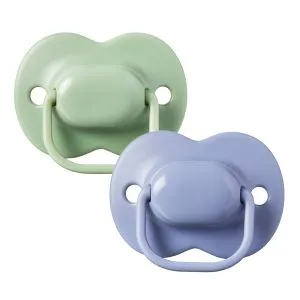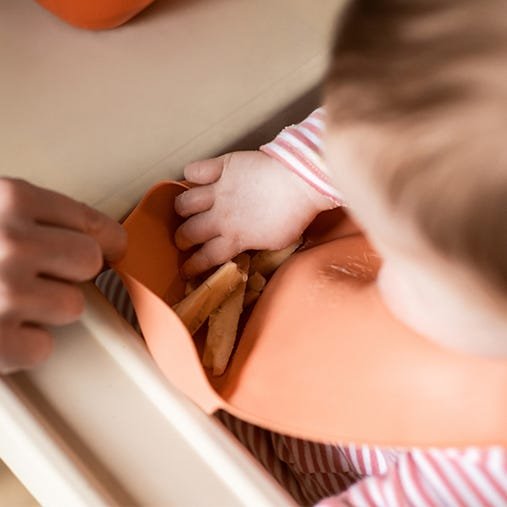How to start baby-led weaning
Baby-led weaning involves setting out soft food in front of your little one on a table or highchair and letting them take control of feeding.
The food is usually served in small, soft pieces that can be held in the baby's hand, rather than being offered on a spoon. First, they will use their hands, then move on to using cutlery.
Perfect baby-led weaning foods to help you get started include things like toast batons, cucumber or carrot sticks, steamed broccoli, chicken, salmon - whatever they're able to hold, squash and sensibly chew, or gum! That's the essence of it.
You should keep on giving your baby feeds of breast milk or formula when you first start weaning. You'll find that as they're gradually able to eat more solids, their number of milk feeds will decrease.
What you'll need for baby-led weaning
Before you start weaning your baby, it's a good idea to get prepared. The following items can help:
Baby-led weaning safety advice
The most common concern around baby-led weaning is safety and choking, and many parents ask if baby-led weaning is safe. The truth is, one recent study found there's no increased choking risk for babies who feed themselves solid foods compared to spoon-fed infants. Therefore, baby-led weaning is no more dangerous.
Often, babies are not choking when they eat, but gagging. Gagging may appear similar to choking at first glance, and can be scary, but they're entirely different. So, it can help to know what to look out for.
Gagging is caused by your baby's gag reflex. This is a natural safety mechanism we have to help prevent choking. Your little one may also gag on foods they're trying for the first time. This is because their taste buds aren't yet used to these new flavours and textures.
Gagging is sometimes mistaken for choking. But don't worry, gagging is a perfectly normal part of tasting new foods. If you recognise the signs of gagging, don't try to help your baby or prevent them from vomiting, as this can cause them to choke.
Signs of gagging include...
- loudly gurgling, coughing, or sputtering
- regurgitating swallowed food back into their mouth
- baby's tongue may be thrust forward
- possible spitting up or vomiting
- possible red face.
It's always important for parents to know the signs of choking, just in case. These include...
- Having difficulty breathing or coughing
- Having a terrified expression on their face
- Making high-pitched noises while breathing
- Face and lips that turn blue
- Struggling to make a sound.
To keep your baby safe while they're weaning, you should...
Sit them upright, facing the table, either on your lap or in a highchair and make sure they can sit steadily and use their hands and arms freely.
Never leave them alone with food and always monitor them at mealtimes.
Discuss the introduction of solids with your health advisers if your family has a history of food intolerance, digestive problems, allergies or any other concerns about your baby's health or development.
Best BLW first foods
There's no set amount of food that babies should eat during the BLW process. The idea of this method of weaning is that they'll tell you when they've had enough. Plus, since they're still having breast milk or formula feeds until they're at least a year old, they're sure to get all the calories they need.
- Start with steamed, sliced food that your baby can chew and swallow easily.
- Give soft fruits and vegetables at first, and then introduce lightly cooked foods that can be chewed or gummed.
- All foods you give need to be soft enough to be mashed with the tongue or between your fingers.
- Good first soft foods include avocado, banana, steamed sweet potato or steamed carrots.
- Your baby's first foods should be baton-shaped like a finger, and easily fit in their little hand.
- As your baby weans onto solid foods from the age of six months, it's important to make sure that they're getting enough iron in their diet (as milk feeds alone won't provide enough). You can do this by including iron-rich foods like dark leafy greens and wholegrains in their meals.
At first, it's all about exploring the food and creating a mess more than eating for your baby, but that's part of the process! Then, you can try to introduce one new food each day for your baby to explore as they grow. This way, they have a variety of foods and discover more options they enjoy, and you can see what kind of foods and shapes they prefer.
BLW foods by age
Now that we've covered what baby-led weaning is, let's run through some recommendations for the best foods for baby-led weaning by age.
BLW foods: 6 months
- Soft, mashed, or blended vegetables and fruit, such as broccoli, carrot, sweet potato, parsnip, apple, and pear.
- Baby rice mixed with breast or formula milk.
- Toast strips.
- Unflavoured Greek yoghurt.
- Soft cheese, like ricotta or mozzarella.
- Steamed strips of tofu.
- Unflavoured pureed meat, such as chicken, turkey, or beef, that's shaped into sticks or strips.
- Very small amounts of foods that may trigger an allergic reaction (these should be introduced one at a time). These can include cow's milk that has been mixed with food, cooked eggs, crushed nuts and seeds, soya, cooked shellfish, and fish.
BLW foods: 7-9 months
As well as the foods listed above, from seven months, you can start to introduce:
- Thinly sliced or halved fruits, like strawberries, blueberries, and raspberries
- Harder cheese, like Swiss or cheddar, that's cubed or grated.
- Cooked whole-wheat pasta
- Cooked pulses and beans
- Whole grain cereal O-s
- Minced meat and halved meatballs
BLW foods: 10-12 months+
By the age of 10 months, little ones should be having three meals a day - with lunch and dinner including a main course and dessert of fruit or plain yoghurt.
BLW foods to avoid
There are certain foods that it's best for your baby or toddler to avoid altogether when weaning. These include:
- Salt and sugar: Babies don't need sugar and too much salt isn't good for their kidneys.
- Saturated fats: Babies shouldn't eat too many fatty foods such as crisps, biscuits, and cakes.
- Honey: Honey can cause a very serious illness called infant botulism, so babies shouldn't have honey until they're over one year old.
- Peanuts and whole nuts: Whole nuts can be choking hazards and should be avoided. But babies can have nuts and peanuts from around six months old if they're smoothed into a butter. If there's a history of allergies in your family, you should talk to your doctor before introducing nuts into your baby's diet.
- Mould-ripened or unpasteurised cheese: Babies and young children shouldn't eat these because of the risk of listeria.
- Raw or lightly cooked eggs: Babies can have eggs from around six months if the white and yolk are both fully cooked.
- Rice-based drinks: Children under five years old shouldn't have rice drinks as they can contain too much arsenic.
- Popcorn, raw jelly cubes, boiled or sticky sweets and ice cubes: These can be a choking hazard for babies and young children.
- Fresh and dried fruits, such as raisins: If your baby is under one years old, always cut fruits into small pieces and never give them whole, as they can pose a choking hazard.
- Raw shellfish, shark, swordfish, and marlin: Raw or lightly cooked shellfish can increase the risk of food poisoning. Plus, the amount of mercury in shark, swordfish, or marlin can affect the development of a baby's nervous system.










